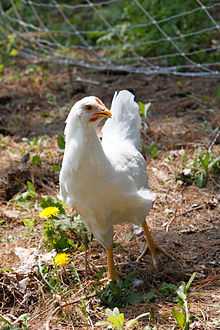Plymouth Rock chicken
 A Barred Rock hen as part of a small backyard flock (with eglu in background) | |
| Conservation status | Recovering |
|---|---|
| Other names | Rocks, Barred Rocks |
| Country of origin | USA |
| Use | Dual-purpose breed |
| Traits | |
| Weight | Male: 8+ lbs. |
| Female: 7.5 lbs. | |
| Skin color | Yellow |
| Egg color | Brown |
| Comb type | Single |
| Classification | |
| APA | American |
| PCGB | Soft Feather: Heavy[1] |
|
Chicken Gallus gallus domesticus | |
The Plymouth Rock, often called simply Rocks or Barred Rocks (after their most popular color), is a chicken breed that originated in the United States. The Plymouth Rock is a dual-purpose, cold-hardy bird and therefore makes a great breed for the small farm or backyard flock owner. The Barred Rock is often called the Plymouth Rock, but this title correctly belongs to the entire breed, not just the Barred variety.
Origin
The Plymouth Rock was developed in New England in the middle of the 19th century and was first exhibited as a breed in 1849. Several individuals claimed its invention, using crosses of Dominiques, Black Javas, Cochins, and perhaps Malays and Dorkings. John C. Bennett (1804–1867) has been credited with either creating or popularizing the breed. Plymouth Rocks were bred as a dual-purpose fowl, meaning that they were valued both for their meat and for the hens' egg-laying ability. The first Plymouth Rock was barred and other varieties were developed later.
The breed became popular very rapidly, and in fact, until World War II, no breed was ever kept and bred as extensively in the United States as the Barred Plymouth Rock. Its popularity came from its qualities as an outstanding farm chicken: hardiness, docility, broodiness, and excellent production of both eggs and meat. Most of the other varieties were developed from crosses containing some of the same ancestral background as the barred variety. Early in its development, the name Plymouth Rock implied a barred bird, but as more varieties were developed, it became the designation for the breed. The Barred Plymouth Rock was one of the foundation breeds for the broiler industry in the 1920s, and the White Rock continues to be used as the female side of the commercial broiler cross. The Barred Plymouth Rock is also raised for genetic hackle used extensively as a material in artificial fly construction.
The Plymouth Rock had its moment of fame also in the scientific world: it was used as a study object of virus-induced oncogenesis. Francis Peyton Rous, a pathologist working at Rockefeller University in New York City discovered in 1911 retrovirus (called nowadays Rous sarcoma virus) responsible for chicken neoplasm, characteristic for that breed. This discovery brought him a Nobel Prize in Physiology or Medicine in 1966.
Characteristics

Plymouth Rocks are large, long-lived chickens. Some varieties are good layers while others are bred principally for meat. They possess a long, broad back; a moderately deep, full breast; and yellow skin and legs. The hens have a deep, full abdomen, which is a sign of a good layer. The face of a Plymouth Rock is red with red ear lobes, a bright yellow beak, bay-colored eyes, and a single comb of moderate size. Their feathers are fairly loosely held and short but not so long as to easily tangle. The chicken's bottom feathers are soft and downy, like baby chicks feathers.
In terms of temperament, both roosters and hens are calm and will get along well with people and other animals such as pets. The hens often will go broody if in the right environment, and are good mothers.
Colors
There are eight colors of Plymouth Rocks recognized in most of the world, but in Australia, the barred color is split into two separate colors, Dark Barred and Light Barred. The difference between these colors is highly noticeable, with the bars of white color wider and the grey lighter in the Light Barred, than in Dark Barred.
The list of colors correct for most of the world (Namely the United Kingdom, America and Canada), is the following:
- Barred
- White
- Buff
- Partridge
- Silver Penciled
- Blue
- Columbian
- Black
With the following list correct for Australia, as per the Australian Poultry Standard, 1st Edition:
- Light Barred
- Dark Barred
- White
- Buff
- Partridge
- Silver Penciled rainbow
- Blue
- Columbian
- Black
Eggs
Plymouth Rocks lay a large egg that varies in color from light to medium brown with a touch of pink. The birds continue laying throughout the winter but with decreased production. The amount of eggs laid is dependent upon the strains of the birds.
Weight
The standard weights for Plymouth Rocks, as established by the American Poultry Association, are as follows: cock - 9-1/2 pounds; hen - 7-1/2 pounds; cockerel - 8 pounds; and pullet - 5-6 pounds.
Approximate weight
| Rooster | 3.4 kg | 7.5 – 9.5 lbs |
|---|---|---|
| Hen | 3.0 – 3.4 kg | 6.6 – 7.5 lbs |
| Cockerel | 3.6 kg | 8.0 lbs |
| Pullet | 2.3 – 2.7 kg | 5.0 – 6.0 lbs |
See also
| Wikimedia Commons has media related to Barred Plymouth Rock. |
References
- ↑ Breed Classification. Poultry Club of Great Britain. Accessed August 2014.
- http://www.mypetchicken.com/chicken-breeds/Plymouth-Rock-B85.aspx
- http://www.backyardchickens.com/breeds/plymouth_rock/8269
- http://www.plymouth-rock-poultry.co.uk/barredplymouthrocks.htm
- Australian Poultry Standard, 1st Edition, Published 1998, Victorian Poultry Association Inc.
- http://www.plymouthrock.webs.com/standard.htm - Plymouth Rock Club of Australia Inc, Australian Plymouth Rock Standard.
- http://forum.backyardpoultry.com/viewtopic.php?f=10&t=7979880 - Plymouth Rock Profile, Backyardpoultry.com
| ||||||